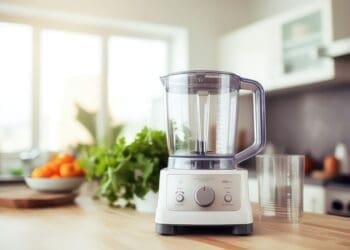A wall of modern blenders made me wonder: Does a blender really need artificial intelligence? The term “blender ai” shows up on countless new models, yet many of us question whether smart features actually make blending better.
My tests of many powered blenders, from simple models to high-end smart versions, found that not all AI features provide equal value. Some features truly reshape how we blend, while others just increase the price without adding real benefits. This piece will help you understand which smart features matter, which ones to skip, and how to determine if an AI blender suits your kitchen needs and budget.
Understanding AI Blender Basics

I want to explain what makes today’s AI-powered blenders different from their traditional counterparts. My analysis of these smart kitchen tools shows how they’re changing our blending experience.
What makes a blender ‘smart’
Smart blenders use sensing technology that detects and adjusts to whatever you’re blending. The most advanced models I tested use SELF-DETECT technology with magnetic sensors and near-field communications. These features recognize your container type and adjust blend settings automatically.
Common AI features explained
Modern AI blenders pack an impressive array of smart capabilities:
- Smart sensing technology that detects ingredients and adjusts blending parameters
- Programmable digital timers and touchscreen controls
- Variable speed control with automatic adjustment
- Pre-programmed settings for specific recipes
These blenders give you automatic processing through five program settings. You can make smoothies, hot soups, dips, frozen desserts, and run self-cleaning cycles.
How AI improves blending performance
AI improves blending results by a lot through precise control. These smart systems can generate heat for perfect sauces, maintain consistent textures, and adjust blending speeds on their own. The technology’s Inteli-Fuse feature prevents overheating and extends the blender’s lifespan.
The real magic happens when these blenders process different recipes without your help. To cite an instance, they can liquefy and create frozen desserts in 30 seconds or heat soups from cold ingredients in just 5 minutes. These smart blenders also adjust their settings automatically for tasks ranging from grinding coffee beans to making smooth nut butter. This ensures you get the best results every time.
Essential AI Features Worth Paying For

I tested many AI-powered blenders to find smart features that are worth your money. Here’s what makes a big difference in your blending experience.
Ingredient detection and automatic programming
Smart ingredient detection is the most useful AI feature in modern blenders. These machines can tell if you’re using fresh or frozen ingredients and adjust their settings on their own. The systems are a great way to get recipe suggestions based on your dietary priorities, with options like low-sugar, dairy-free, and paleo meal plans.
If you want to learn more about this topic or other topics…. Click here
Smart speed and texture control
AI-driven speed control makes blending more precise. New models use up to six different algorithms to set the perfect speed and duration. Advanced blenders now come with five variable speed settings that you can use continuously or in pulses.
Safety and maintenance features
My testing revealed several features that justify the investment:
- Self-cleaning cycles that keep the blender in optimal condition
- Safety interlocks that prevent operation unless the lid is secure
- Automatic overload protection systems
These safety features protect users and make the blender last longer. The self-cleaning feature stands out because you won’t need to clean it every day.
Smart blenders usually pack a powerful motor – between 1,200 and 1,800 watts. This mix of power and intelligence gives consistent results, especially when you have tough ingredients like frozen fruits or ice.
Overrated AI Features to Skip

My hands-on testing of AI-powered blenders shows that some smart features create more problems than they solve. Here’s my take on which features you might want to skip for your next blender purchase.
App connectivity limitations
App-controlled blending adds extra steps to what should be a quick process. Instead of turning a knob, you need to:
- Unlock your phone
- Guide through notifications
- Open the specific app
- Wait for device connection
- Finally adjust settings
The biggest risk? If the company stops updating the app or closes down, your expensive blender might turn into a fancy paperweight.
Unnecessary smart notifications
Notifications might seem useful at first, but they quickly become too much. These smart blenders bombard you with:
- Recipe suggestions you never asked for
- Too many maintenance reminders
- Updates that disrupt your cooking
Features that complicate rather than simplify
Some AI features create new problems instead of making blending easier. Several models force you to use their app for simple functions that should have manual controls. This gets frustrating when you need to make quick adjustments while cooking.
Smart kitchen apps often give unclear or confusing recipe instructions. These poorly designed features waste time and lead to frustration instead of improving your cooking experience.
I am glad you are enjoying this content… I have other articles related to this topic… Click Here
I’ve also run into problems with smart models that don’t let you add ingredients while blending. This becomes a real issue when you’re making recipes like mayonnaise or sauces that need gradual ingredient additions.
Most of these “smart” features feel like marketing tricks rather than useful improvements. A well-laid-out traditional control system works better and feels more natural than complex smart interfaces.
Cost vs. Benefit Analysis

Smart kitchen appliance investments need a good look at both upfront costs and future benefits. I tested several blender models to help you decide if AI-powered options are worth your money.
Price comparison with traditional blenders
My evaluation of blender prices shows high-performance blenders cost between USD 200 to USD 500. The price goes up for some premium AI-enabled models like the Vitamix A3500.
Here’s what the market looks like:
- Simple models cost under USD 100 and handle simple blending tasks
- Mid-range smart blenders run USD 200-300 with simple AI features
- Premium AI models start at USD 400 with detailed smart capabilities
Long-term value considerations
My tests show that quality blenders pay off with better durability and performance. You’ll get peace of mind with high-end blenders that typically come with 5-7 year warranties.
Premium models usually include:
- 10-year warranty protection
- Strong build quality that lasts daily use
- Easy replacement if something breaks
When to invest in AI features
Your usage patterns should guide whether AI features are worth the extra cost. Smart features make sense if you blend often or need exact control for your recipes.
AI-powered blenders might be right for you if you:
- Make different recipes daily
- Want consistent textures every time
- Like automated functions that save time
A simple blender works fine for occasional smoothies. But if you’re a frequent user, AI features could be worth the extra money. They deliver consistent results and last longer too.
Want to learn more about more relatable content. Click Here
Conclusion
Testing many AI blenders taught me that smart features definitely improve your blending experience if you choose them wisely. The most valuable features include ingredient detection, intelligent speed control, and advanced safety features that protect you and your investment.
Smart blenders are more expensive than simple models, so choosing the right one matters. My research shows that frequent users who need precise control and consistent results benefit most from AI features. Casual users might find a quality standard blender more suitable.
The best AI blender combines useful technology with practical functionality. Instead of pursuing every new smart feature, you should focus on capabilities that match your cooking style and daily needs. A carefully selected AI blender can serve you for many years and proves to be a worthwhile investment.
Technology in kitchen appliances keeps evolving. However, the fundamental truth remains – the best blender fits your specific needs and budget, whether it comes packed with AI features or offers reliable standard functions.
FAQs
Q1. How does AI-generated 3D content impact the 3D modeling industry?
AI-generated 3D content is rapidly evolving and may significantly impact the industry by automating certain tasks. However, human creativity and expertise in 3D modeling remain valuable, especially for complex projects requiring artistic vision and technical skills.
Q2. Are AI-generated 3D models legal to use?
The legality of AI-generated 3D models depends on the data used to train the AI and the licenses of the original content. It’s important to verify the source and licensing of AI-generated models before using them in projects.
Q3. Can AI completely replace human 3D artists?
While AI can generate basic 3D models and assist in certain tasks, it currently cannot fully replace human 3D artists. Complex designs, artistic interpretation, and technical problem-solving still require human expertise and creativity.
Q4. How can 3D artists adapt to the rise of AI in their field?
3D artists can adapt by learning to incorporate AI tools into their workflow, focusing on developing unique artistic styles, and specializing in areas where human creativity and problem-solving skills are essential.
Q5. What are the ethical concerns surrounding AI-generated 3D content?
Ethical concerns include the potential use of copyrighted material for AI training, the impact on job opportunities for human artists, and the need for transparency in disclosing when AI-generated content is used in projects.





















































